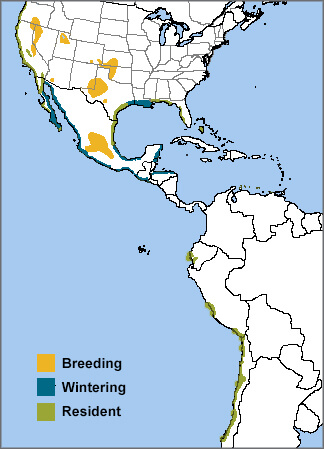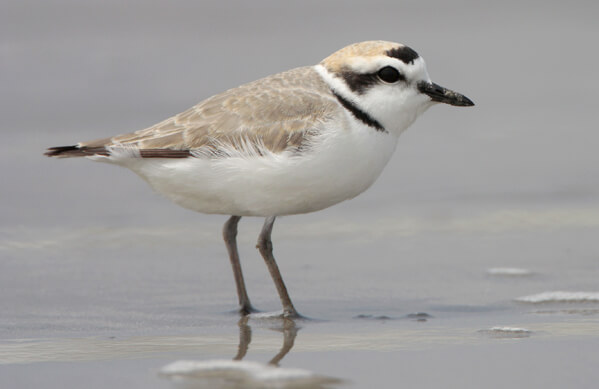
Snowy Plover range map by American Bird Conservancy
The sparrow-sized, sand-colored Snowy Plover is a bird rarely seen far from shorelines, where its pale plumage provides the perfect camouflage. It can be distinguished from the similar and closely related Piping Plover by its partial black collar and black legs and feet.
Only in the Americas
Until recently, the Snowy Plover was considered the same species as the Kentish Plover (Charadrius alexandrinus) of Eurasia, Africa, and Australia. Genetic analysis showed that the two are different species, and so the Snowy Plover was split from the Kentish Plover in 2011.
The Snowy Plover is found only in the Americas. It is smaller, with shorter legs and wings, and lacks the rusty-orange nape that its Kentish cousin sports in breeding plumage.
White on White
The Snowy Plover's preferred habitats are open, sparsely vegetated coastal beaches, salt flats, and the shores of inland alkaline lakes. With its light color, the Snowy Plover is often very well camouflaged on white, sandy beaches and lake beds.
There are two recognized subspecies of the Snowy Plover. One breeds along the Pacific Coast from Washington to the Baja Peninsula, in portions of the Great Basin and Great Plains, in central Mexico, and along the Gulf Coast from Louisiana through Florida, as well as in parts of the Caribbean. The Pacific Coast population is known as the "Western" Snowy Plover.
A second subspecies is resident along the Pacific slope of South America from Ecuador to Chile.
In North America, this plover is a short-distance migrant, with inland populations moving to coastal areas on the Gulf or Pacific Coasts for the winter. Birds from the western part of the Great Basin (an arid watershed that encompasses Nevada, much of Oregon and Utah, and parts of California, Idaho, Wyoming, and Baja California, Mexico) winter on the California and Baja California coasts, where they can be found with resident breeders from the Pacific Coast. Snowy Plovers breeding in the Great Plains winter on the shores of the Gulf of Mexico.
The Snowy Plover's mellow-sounding calls include trilled purrt and tur-weet notes.
Listen here:
(Audio: Paul Marvin, XC143722. Accessible at www.xeno-canto.org/143722)
Pattering Plovers
The Snowy Plover is a visual forager, scampering over sand and mudflats, then pausing to peck at prey it spots on the ground. Its large eyes and acute vision allow it to feed both during the day and at night, when its prey may be more active. This plover's preferred diet consists of small crustaceans, insects, and tiny fish, as well as mollusks and marine worms.
In common with unrelated birds such as the Hermit Thrush, the Snowy Plover uses “foot-pattering” to find food. When employing this strategy, the plover stands still and taps one foot rapidly on the ground, generating small vibrations, which are thought to lure worms and other underground prey closer to the surface and within reach of a hungry bird's beak.

Snowy Plover nest, eggs, and chick. Photo by Katheryn Harris
Multiple Broods, Different Mates
Snowy Plovers, along with other beach-nesting birds such as the Black Skimmer, Least Tern, and American Oystercatcher, nest on the ground, creating small hollows called scrapes for their nests. These scrapes are often placed close to bits of shoreline debris such as driftwood, vegetation, or clumps of seaweed, and are lined with bits of shell or pebbles.
Like the Killdeer and other ground-nesting birds, the Snowy Plover uses a "broken wing" distraction display to try to lure potential predators away from the nest and chicks.
This plover frequently raises two broods a year, and sometimes three in places where predation is low. Both male and female take turns incubating the clutch of two to three eggs. Chicks hatch open-eyed and covered with down. They are fully mobile and leave the nest within hours of hatching, though they still require parental care until they can fly on their own, about a month later.
Some Snowy Plover populations exhibit serial polygamy, a breeding system in which one of the pair — in this species, usually the female — leaves its mate soon after the eggs hatch, and starts a new brood with a different mate. The abandoned male raises the young, then after that may also start another nest with a new mate.
Fish, Swim, and Play from 50 Yards Away
Because in many areas its preferred nesting habitat is sandy beaches, the Snowy Plover is vulnerable to a variety of human disturbances. Habitat loss to coastal development, beach use by off-road vehicles, and predation by cats, dogs, and other animals are among the threats these birds face. Introduced invasive vegetation and sea-level rise caused by climate change also gobble up suitable Snowy Plover habitat.
The Snowy Plover is listed as endangered or threatened in several states and is included on the 2014 State of the Birds Watch List. The "Western" Snowy Plover, a population that breeds along Pacific Coast and Baja California, was federally listed as Threatened in 1993.
ABC leads a Gulf Coast conservation effort to identify and provide protective actions for Snowy Plovers and other vulnerable beach-nesting birds. With two of our key partners, Houston Audubon Society and Coastal Bend Bays & Estuary Program, we're monitoring populations of Snowy Plovers across the upper and central Texas coast. ABC also promotes the "Fish, Swim, and Play from 50 Yards Away" program each year, which aims to educate tourists and local residents about the needs of Snowy Plovers and other imperiled bird species that nest on beaches along the Gulf Coast.
Donate to support ABC's conservation mission!



















































